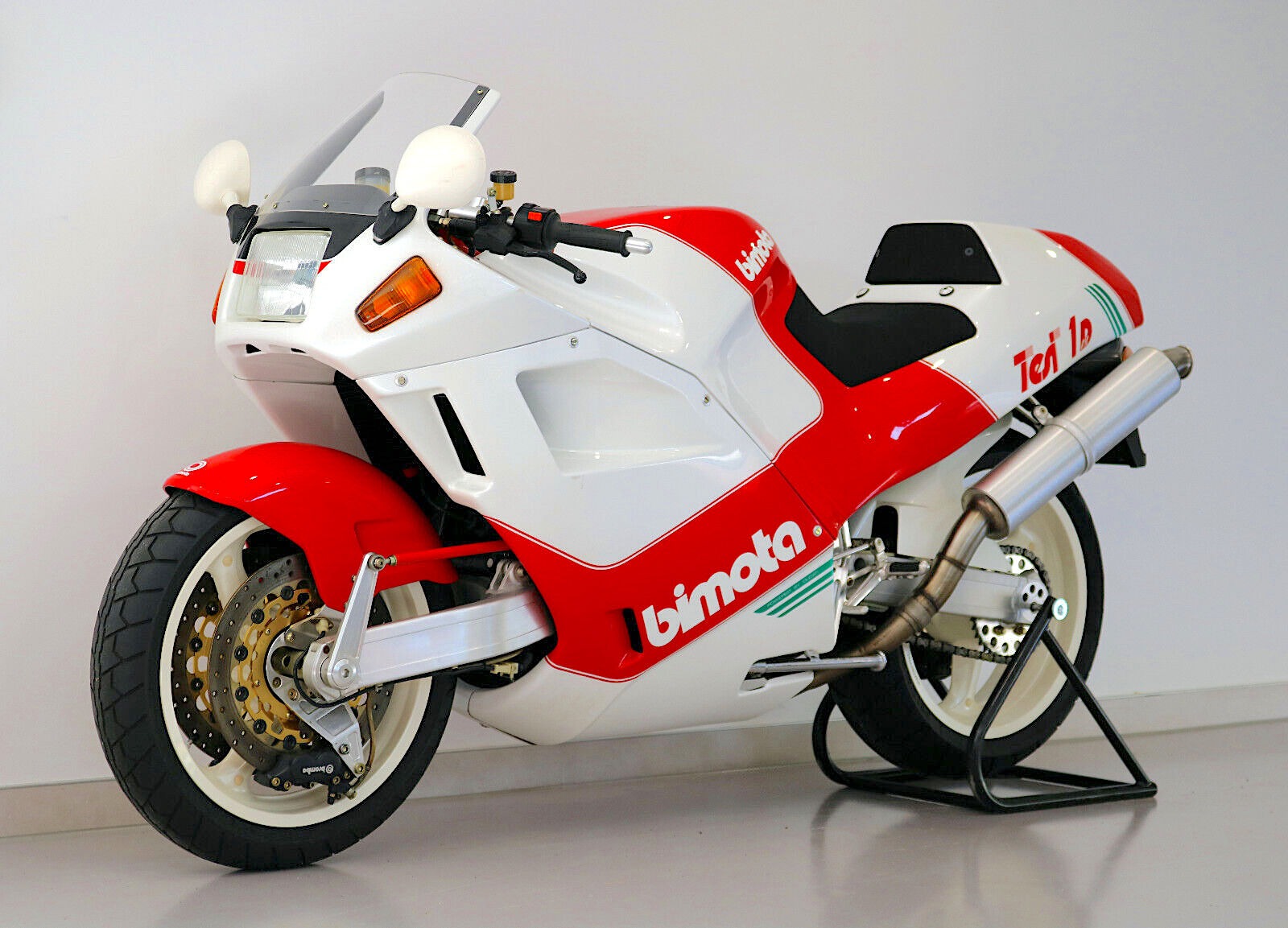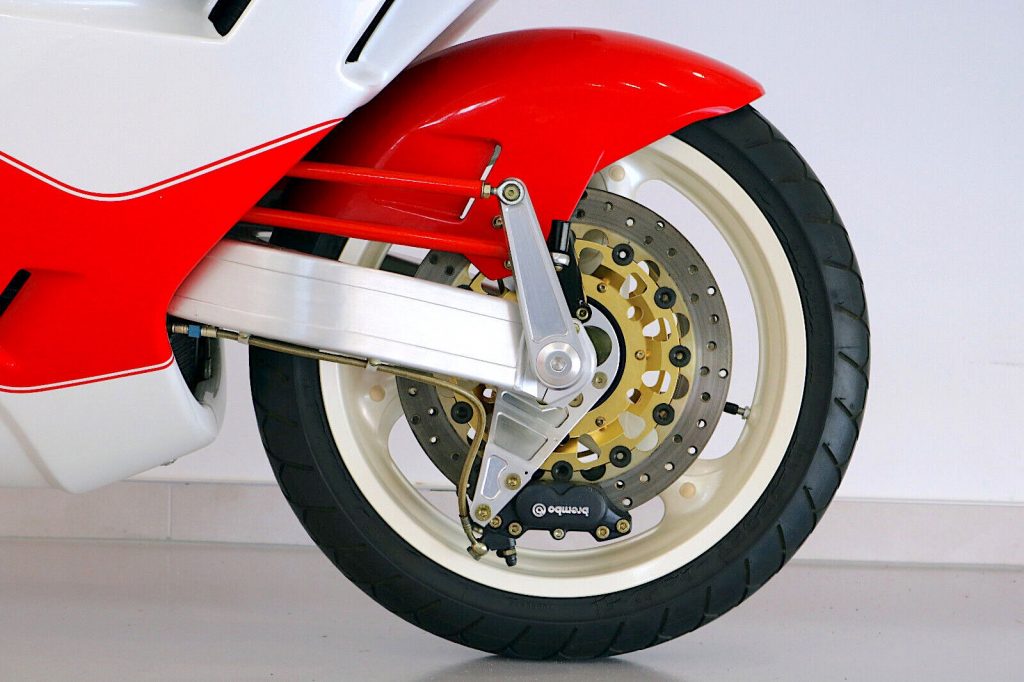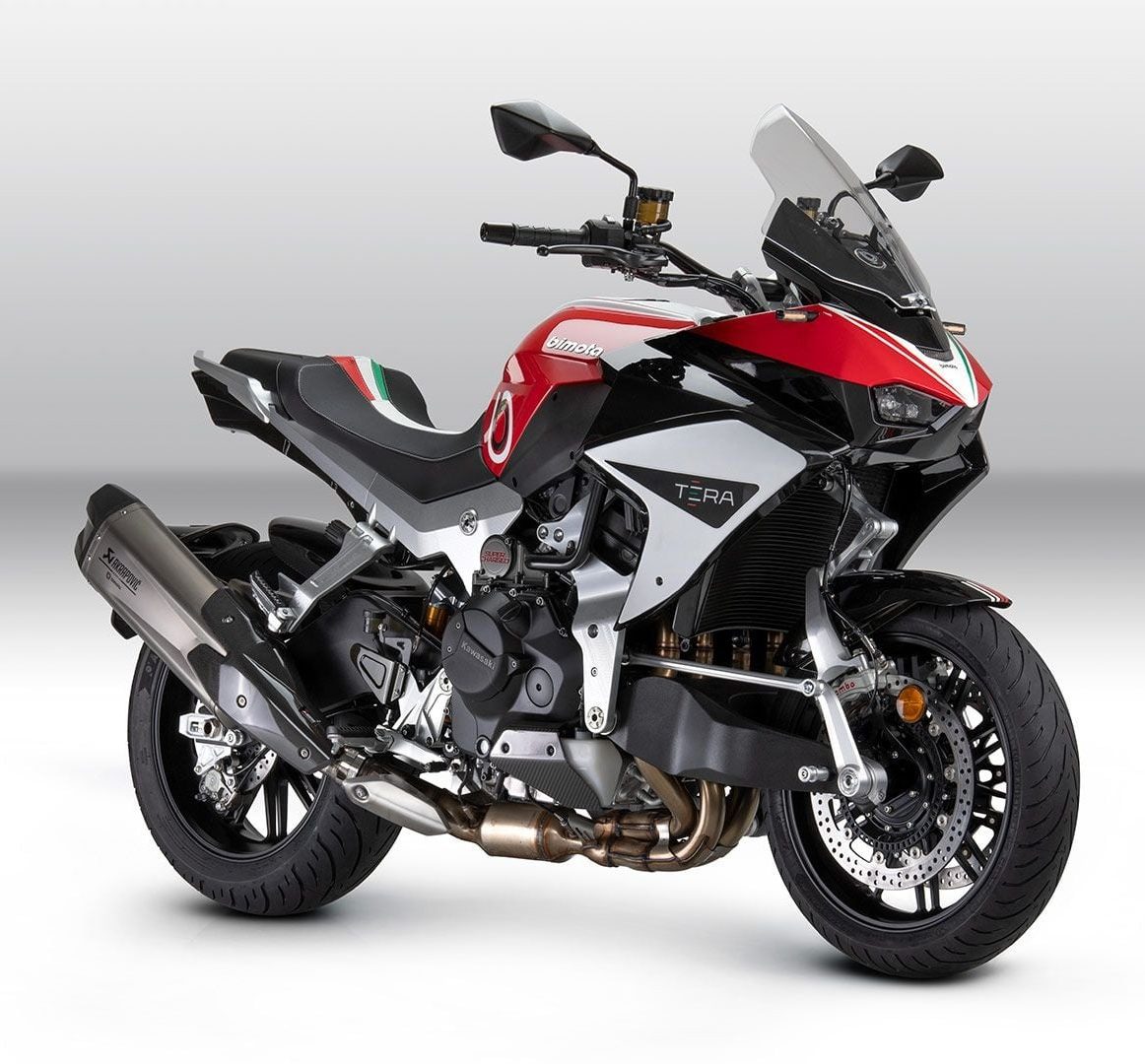Every year, motorcycle manufacturers show off their latest and greatest technology at EICMA in Milan. At EICMA you’re bound to see neat electric motorcycles from startups, fabulous prototypes from big names, and frankly baffling creations from boutiques. Bimota regularly falls into that final spot. Last year, the brand showed off a futuristic café racer. This time around, we’re getting the brand’s first-ever adventure-tourer, and Bimota made sure to crank the weird up to 11. This is the Bimota Tera, and it’s a touring bike with a new version of Bimota’s signature hub-center steering. Bimota seemingly used a “Rube Goldberg” approach to make this bike and that’s what makes it great.
The adventure-touring motorcycle is a blending of two popular segments. Sometimes called a crossover, street-oriented adventure motorcycles look butch like an ADV and will sometimes have some minimum levels of off-road capability, but have elevated on-road performance. A Harley-Davidson Pan America and the BMW GS are good examples of more traditional adventure bikes while something like a Ducati Multistrada V4 RS is one of these crossovers. I mean, the Duc’s marketing materials show it doing wheelies and leaning over on a track, not storming down a trail. You could argue that my long-term Zero DSR/X loaner is also an adventure-tourer given its on-road prowess and reduced off-road chops.
Bimota is the latest player in this crossover space with its new Tera.

Unveiled at this year’s EICMA show, the Tera has been in development for about three years and it showcases the latest example of Bimota’s hub-center steering, technology that Bimota has been refining for over 40 years. Oh, and since Bimota is under the wing of Kawasaki, power comes from a supercharged H2 engine good for 200 HP and 101 lb-ft of torque, in case you want to speedrun your adventures.
A Weird Option

Bimota has been around since 1966 and the brand has built a reputation for crafting boutique bikes you won’t find anywhere else. In the brand’s early days, Bimota created strong, lightweight frames for other motorcycles. You would buy the motorcycle of your choosing then convert it into a faster and lighter Bimota with a kit.
Bimota moved on to building full motorcycles combining existing engines with its fine engineering. However, for many riders, the name Bimota conjures up images of the brand’s wild steering system. As reported by Fast Bikes Mag, in the early 1980s, Pier Luigi Marconi and Roberto Ugolini developed a university degree course thesis on a revolutionary new type of motorcycle front wheel. The vast majority of motorcycles had front wheels rotating around an axle, which was secured to a fork, itself secured to the motorcycle’s frame. To turn the wheel, you turned the handlebars, which turned the entire fork assembly. Most motorcycles still use traditional forks and they do the job.

The men would ditch the whole fork idea, instead going with an oscillating swingarm. The front wheel is steered using linkages and a special hub with an internal pivot point. The idea of a hub-center steering is to split up steering, braking, and suspension functions, rather than have them all together like in a typical motorcycle fork. The motorcycle bearing this tech would become the Tesi, short for Thesis. If you’re having trouble visualizing this, watch this video:
When you hit the front brake with a motorcycle with forks, you will get front end dive and your steering geometry will also change. By separating these functions, Bimota’s novel steering system promises to eliminate those potentially unwanted dynamics. To be clear, Bimota didn’t invent hub-center steering. The concept has been around for well over a century and it’s been tried out a number of times by different companies, each with their own approach.
The Ner-A-Car had hub-center steering, as did a Yamaha, a Suzuki, a Vyrus, and other motorcycles. For an example of how another builder does it, Suzuki’s hub-center design used hydraulic cylinders and lines to link the grips to the front wheel.

Unfortunately, hub-center steering has proven to be more boutique than mainstream. Bimota reportedly burned a lot of cash on the Tesi, only to find out that there weren’t many riders willing to pay the price for the novel steering system. The brand went bankrupt in 2001 after failures including the Tesi and its V Due project.
Despite this, Bimota never gave up on the Tesi or its hub-center steering. The latest version of the Tesi, the Tesi H2, is on sale today. And now, Bimota, the boutique brand known for building motorcycles the craziest way, is applying the concept to its first-ever adventure-tourer.
The Bimota Tera

The highlight of the new Tera is its updated version of Bimota’s hub-center steering. One of the downsides of the Tesi design is that the hub-center steering has a limited range of motion, making tight maneuvers more difficult for the rider. The Tesi H2’s design has a steering angle of just 19 degrees. The Tera is a leap forward for Bimota, offering 35 degrees of steering angle, which should allow for far easier tight maneuvers.
Also new is the knee-type link which ties the handlebar to the shock absorber and steering assembly. It almost looks like some sort of alternate reality motorcycle fork.

Aluminum arms with connected rods control vertical movement and integrated into all of this are the motorcycle’s front brakes. In addition to a far greater steering angle, Bimota’s new steering system is also flexible. The company says that thanks to this system, future riders may have the ability to modify their bikes to manually or electronically change damping response and adjust ride height by 30 millimeters.
Past iterations of this design, such as the steering of the Tesi H2, used an elaborate set of control linkages running down the side of the motorcycle that led their way to the front wheel. Here’s a photo of the Tesi H2’s steering:

The frame consists of billet machined aluminum plates plus some steel tubing, which appears to support the steering system and bars. There’s also a rear swingarm mounting plate and the engine serves as a stressed member. Bimota calls this an evolution of the Tesi’s chassis. Speaking of that engine, the Tera gets the 998cc supercharged inline-four H2 engine, good for 200 HP at 11,000 RPM and 101 lb-ft of torque at 8,500 RPM.
Holding all of this up is are Öhlins TTX36 shocks in front and back. Up front, there’s 4.48 inches of wheel travel while the rear gets 5.31 inches. Optional is a Marzocchi semi-active suspension system with 5.7 inches of travel up front and 6.49 inches in the rear. Stopping is handled by 330mm floating front discs clamped on by 4-piston Brembo Stylema calipers. A single 220mm disc brings up the rear with its own 2-piston caliper.


Seat height comes in at 32.28 inches, plus or minus about an inch. To give you an idea of what I mean by a street-oriented adventure bike, the ride height is 6.85 inches, plus or minus about an inch. To put that into perspective, some of the more popular proper adventure bikes out there tower as high as 9.4 inches off of the ground.
Bimota hasn’t released full specifications for the motorcycle just yet but says it has a 56.89-inch wheelbase, a 440-pound curb weight, ABS, and a display for instrumentation. The company also hasn’t revealed when it’ll go on sale or how many organs you’ll need to sell to afford it. To give you an idea of what you’ll be working with here, the Tesi H2 will set you back roughly $72,000, depending on exchange rates, so this will almost certainly be so expensive it’ll make a BMW GS sound like a bargain.

Most of us will probably never see one of these and if we do, it’ll probably be in a private collection or a museum. I doubt you’ll ever see one kicking up rooster tails on a trail. Still, I’m happy it exists. In a world where the word “crossover” can sometimes translate to something bland in the car world, motorcycle manufacturers are still plenty silly. I wish we had more of that!
(Images: Bimota, unless otherwise noted.)

- Dodge Needs To Come Up With More New Muscle Car EV Cool Shit If It Wants To Replace The Hellcat And I’m Here To Help
- When You Confuse The Main Chat For Your DMs: Tales From The Slack
- I Took An Open Air 4×4 Off-Roading In Icy Winter And Here’s Why You Should Too
- Watch Police Officers Stop A Pregnant Woman In A Car With No Brakes From Crashing Into Lake, Then Help Us Figure Out What Happened


Something missing about this type of front end is the geometry. Unlike forks the “rake” is not fixed, bikes like the Tesi can have almost zero rake and still have trail.
Mercedes – where are you getting that 440 lb. curb weight? That is almost certainly an error.
The Tesi is 483 lbs. The Z H2 is 529 lbs.
I am guessing that the 440 lb number is either dry weight or a typo.
Aint it gorgeous!
I applaud Bimota for sticking with hub center steering, in an application where even BMW thinks twice. While most R1100GS and R1200GS versions use Telelever, the HP2 racer had conventional forks and all the F series use teles.
The F-series isn’t suitable for Telelever because of the where the front-swing-arm has to be mounted (the swing-arm rod would have to pass through the same volume as the cylinders).
Telelever worked on the R-series (and “flying brick” K-series) because the swingarm rod could be mounted into the engine cases without interfering with the engine internals themselves. If you look at the original designs for Telelever (Sax Trac I think), the swingarm mounts are in the cradle frame which wraps around the outside of the engine. This system “works” but (I think) isn’t terribly strong and wouldn’t be to BMW’s taste because (at the time) they believed in building long-lived machines, not playthings.
BMW have stuck with Telelever (and the Boxer-twin engines) mainly because they have a core of buyers who will keep buying that combination*, BMW have repeatedly made suggestions about doing away with the system (and the Boxer-twin engine) and the outcry from customers has changed their mind.
*: For general road riding, it’s a hard to beat combination once you’re used to it (which takes a few hundred / thousand miles depending on your riding skills).
I’ll admit to being a Boxer purist after 30 years with an Airhead. I think the HP2 is,the best example of the Telelever’s limitations since it is R1200GS based but uses a conventional fork for more travel. The F and S series seem to be packaging issues
It’s well known that Telelever has “issues” for off-roading. It’s heavier and has less range of movement than Telescopic forks, both disadvantages for off-road use.
It’s a bit of a mystery as to why BMW continue with Telelever for the GS, while removing it from more road-oriented models (eg the RS). I think the general consensus is that they fear the customer back-lash from the GS demographic, who are far more road-oriented in usage than they’d like to admit. 😉
The craziest part of this to me is that the Autopian has been around just over a year now. Wtf. It feels like just earlier this year….
Coming from an academic family as I do, I have to hand it to anyone that names the motorcycle they designed after their thesis. But, working in the field as I do, I’m also somewhat dubious about complicated designs for what looks—to my layman eyes—to be incremental gains. For some reason I can’t even see the video mentioned, much less play it. Maybe I’ll understand when I can view it
the kid in me has to add that I really want that beautiful sculpture of a steering setup in my living space just so I could play with it
Finally watched the video, and have to admit that this is quite cool. I don’t have relevant experience to be able to assess the worth of this on 2 wheels. I did decide to not undo the anti-dive geometry in my Subaru to pursue the better handling characteristics one obtains on gravel, but that’s mostly because I don’t have illusions about my capabilities when cos-playing a WRC driver. Plus it’s probably on pavement 80+% of the time anyway.
my takeaway is that this is for those whose talents overwhelm regular steering. I’m not in that group—2 or 4 wheels
Wonderful madness, probably capable of a 200+mph adventure.
OMFG just imagine!
People periodically experiment with linkage-based forks on mountain bikes too, and I heard a good discussion a while back about why they never take off. It basically boiled down to the fact that traditional forks are simple, well understood, and have been optimized to within an inch of their lives. If you build a non-traditional fork and it’s not better in every single way (price, performance, appearance, etc.) you’re going to have a hard time convincing people to switch. So far linkage forks have always included some level of compromise (they always look weird, for one thing) so people stick with the tried-and-true tube-in-tube fork.
Yeah I just looked up Whyte and they stopped using their BMW Telelever style front end and reverted to telescopic forks
I’ve inherited from my father-in-law a 1995 model ProFlex 755 mountain bike, which uses Girvin girder forks and elastomers (“rubber” hockey pucks) as springing. They work well but a lot of people were reluctant to try something so different, and ProFlex eventually switched to more conventional telescopic forks.
Motorcyclists in particular are extremely conservative in what they like to use. Especially if a change takes time to become accustomed to.
I’ve been riding Telelever bikes for the past 20 years-ish, and every time I ride a telescopic-fork bike now I find it very softly sprung (no matter how well it’s setup), and I can really feel how the dive under braking affects the handling. (Telelever has a small amount of dive built in, but the steering geometry actually lengthens under braking, instead of getting shorter, making the bike more stable under braking, instead of less stable).
Yeah, I’ve heard good things about the riding dynamics. Slacking out the front end instead of steepening it when the suspension compresses seems like a win. My personal biggest concerns are cost and maintenance. I frequently have to change bearings in my rear suspension pivots and I’d just as soon not add a bunch more pivot points. That may be less of a problem on motorcycles though because they can use beefier bearings.
It depends on the use-case. Telelever and other systems aren’t as good off-road because a) they’re heavier, and b) they have a much more limited range of movement than Telescopic* forks.
I’ve had a supercharged car, and highly recommend it.
At the moment I’m not sure how I feel about a supercharged bike, but I am willing to give one a shot.
*makes “call me” motion to Bimota*
Kawasaki will let you kill yourself for way cheaper, with the same motor!
Oh I know, but the Bimota will be much more of a statement when it’s flung off the road or into a ravine or whatever.
All I can see is that apparently even Bimota is now bound by law and blood to install mufflers that look like huge sick stovepipes, like Kawasaki has been doing of lately.
Yes, I know, CARB emissions and whatnot, but still. Yamaha doesn’t seem to be having the same sickness.
Oh, and congrats to Bimota for still being alive.
“Alive.”
Now my mom always told me that if I can’t say anything nice, I shouldn’t say anything at all, and maybe the lack of comments here are because everyone else here is much better about listening to their mothers than I am. It’s just that all these vaporware motorcycle announcements (and particularly e-motos) are literally much ado about nothing.
No specs, no price, no point.
That’s definitely the stock exhaust from the Kawasaki, but it’s still surprising to me. For all the money Bimota is charging you, they don’t automatically put on aftermarket pipes. Other brands will sell you a full aftermarket system straight from the dealer with an ECU flash, so I have to assume it still meets emissions.